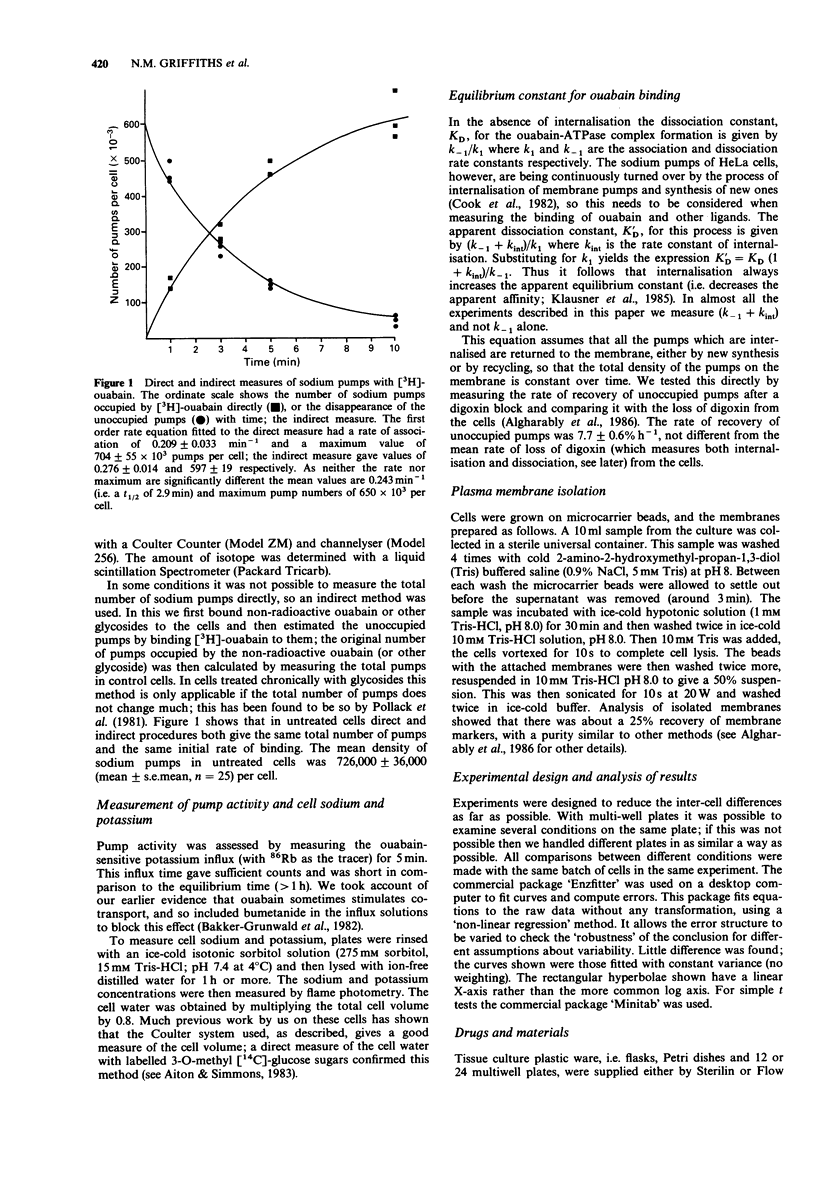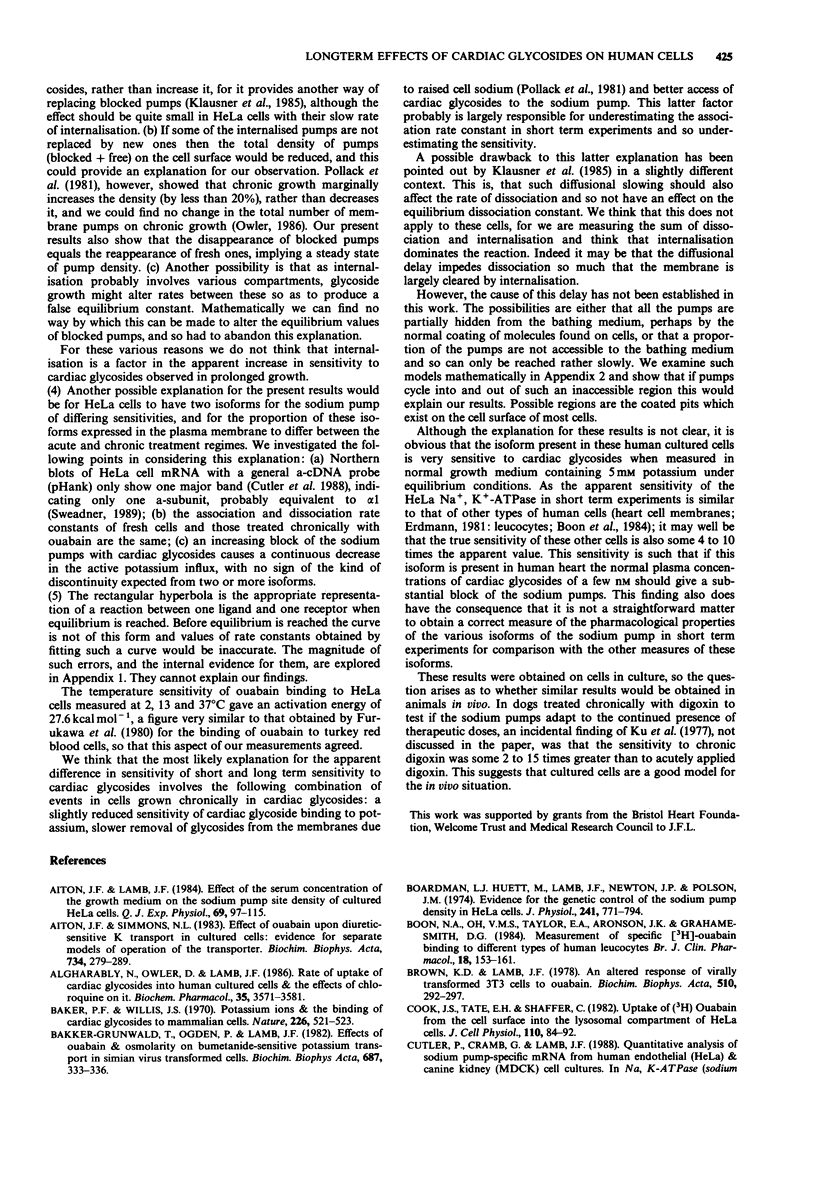Abstract
1. Human cells (HeLa) were cultured for periods up to 48 h in growth medium in the absence or presence of a range of concentrations of cardiac glycosides. In some experiments the potassium concentration of the medium was varied between 0.3 mM and the usual 5 mM. 2. For periods up to 2 h in ouabain the association and dissociation rate constants were measured and the equilibrium binding constant (KD) calculated; the apparent equilibrium binding constant (K'D) was measured after 1-2 days growth in ouabain. 3. Ouabain had a K'D after 2 days of 2-6 nM in 5 mM K+ growth medium, a 4 fold greater blocking effect on sodium pumps after 2 days than expected from the association and dissociation rate constants measured in untreated or previously ouabain-treated cells. 4. This effect was: (a) approximately the same over a range of external potassium concentrations from 0.3 to 5 mM, although the absolute effect of ouabain over this range of potassium was much different; (b) probably not due to different isoforms of pumps in cells grown in ouabain compared to untreated cells; (c) apparently not a consequence of internalisation of pump-glycoside complexes. 5. We conclude that ouabain has only a limited access to sodium pumps in whole cells; this could be because sodium pumps cycle continuously through an inaccessible region of the plasma membrane. This effect needs to be considered both in the assessment of the magnitude of the long term effects of cardiac glycosides on cells, and in the measurement of the glycoside affinities of various isoforms of the pump.
Full text
PDF








Selected References
These references are in PubMed. This may not be the complete list of references from this article.
- Aiton J. F., Lamb J. F. Effect of the serum concentration of the growth medium on the sodium pump site density of cultured HeLa cells. Q J Exp Physiol. 1984 Jan;69(1):97–115. doi: 10.1113/expphysiol.1984.sp002799. [DOI] [PubMed] [Google Scholar]
- Aiton J. F., Simmons N. L. Effect of ouabain upon diuretic-sensitive K+ transport in cultured cells. Evidence for separate modes of operation of the transporter. Biochim Biophys Acta. 1983 Oct 12;734(2):279–289. doi: 10.1016/0005-2736(83)90126-8. [DOI] [PubMed] [Google Scholar]
- Algharably N., Owler D., Lamb J. F. The rate of uptake of cardiac glycosides into human cultured cells and the effects of chloroquine on it. Biochem Pharmacol. 1986 Oct 15;35(20):3571–3581. doi: 10.1016/0006-2952(86)90628-3. [DOI] [PubMed] [Google Scholar]
- Baker P. F., Willis J. S. Potassium ions and the binding of cardiac glycosides to mammalian cells. Nature. 1970 May 9;226(5245):521–523. doi: 10.1038/226521a0. [DOI] [PubMed] [Google Scholar]
- Bakker-Grunwald T., Ogden P., Lamb J. F. Effects of ouabain and osmolarity on bumetanide-sensitive potassium transport in simian virus-transformed 3T3 cells. Biochim Biophys Acta. 1982 May 7;687(2):333–336. doi: 10.1016/0005-2736(82)90564-8. [DOI] [PubMed] [Google Scholar]
- Boardman L., Huett M., Lamb J. F., Newton J. P., Polson J. M. Evidence for the genetic control of the sodium pump density in HeLa cells. J Physiol. 1974 Sep;241(3):771–794. doi: 10.1113/jphysiol.1974.sp010684. [DOI] [PMC free article] [PubMed] [Google Scholar]
- Boon N. A., Oh V. M., Taylor E. A., Johansen T., Aronson J. K., Grahame-Smith D. G. Measurement of specific [3H]-ouabain binding to different types of human leucocytes. Br J Clin Pharmacol. 1984 Aug;18(2):153–161. doi: 10.1111/j.1365-2125.1984.tb02447.x. [DOI] [PMC free article] [PubMed] [Google Scholar]
- Brown K. D., Lamb J. F. An altered response of virally transformed 3T3 cells to ouabain. Biochim Biophys Acta. 1978 Jul 4;510(2):292–297. doi: 10.1016/0005-2736(78)90029-9. [DOI] [PubMed] [Google Scholar]
- Cook J. S., Tate E. H., Shaffer C. Uptake of [3H]ouabain from the cell surface into the lysosomal compartment of HeLa cells. J Cell Physiol. 1982 Jan;110(1):84–92. doi: 10.1002/jcp.1041100114. [DOI] [PubMed] [Google Scholar]
- Emanuel J. R., Garetz S., Schneider J., Ash J. F., Benz E. J., Jr, Levenson R. Amplification of DNA sequences coding for the Na,K-ATPase alpha-subunit in ouabain-resistant C+ cells. Mol Cell Biol. 1986 Jul;6(7):2476–2481. doi: 10.1128/mcb.6.7.2476. [DOI] [PMC free article] [PubMed] [Google Scholar]
- Furukawa H., Bilezikian J. P., Loeb J. N. Kinetics and thermodynamics of ouabain binding by intact turkey erythrocytes: effects of external sodium ion, potassium ion, and temperature. J Gen Physiol. 1980 Oct;76(4):499–516. doi: 10.1085/jgp.76.4.499. [DOI] [PMC free article] [PubMed] [Google Scholar]
- Griffiths N., Lamb J. F., Ogden P. The effects of chloroquine and other weak bases on the accumulation and efflux of digoxin and ouabain in HeLa cells. Br J Pharmacol. 1983 Aug;79(4):877–890. doi: 10.1111/j.1476-5381.1983.tb10532.x. [DOI] [PMC free article] [PubMed] [Google Scholar]
- Ku D. D., Akera T., Brody T. M., Weaver L. C. Chronic digoxin treatment on canine myocardial Na+, K+ -ATPase. Naunyn Schmiedebergs Arch Pharmacol. 1977 Dec;301(1):39–47. doi: 10.1007/BF00501262. [DOI] [PubMed] [Google Scholar]
- Lamb J. F., McCall D. Effect of prolonged ouabain treatment of Na, K, Cl and Ca concentration and fluxes in cultured human cells. J Physiol. 1972 Sep;225(3):599–617. doi: 10.1113/jphysiol.1972.sp009959. [DOI] [PMC free article] [PubMed] [Google Scholar]
- Pollack L. R., Tate E. H., Cook J. S. Na+, K+-ATPase in HeLa cells after prolonged growth in low K+ or ouabain. J Cell Physiol. 1981 Jan;106(1):85–97. doi: 10.1002/jcp.1041060110. [DOI] [PubMed] [Google Scholar]
- Sweadner K. J. Isozymes of the Na+/K+-ATPase. Biochim Biophys Acta. 1989 May 9;988(2):185–220. doi: 10.1016/0304-4157(89)90019-1. [DOI] [PubMed] [Google Scholar]


